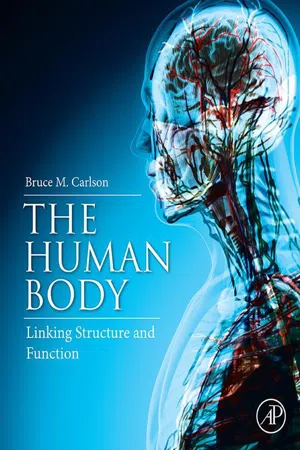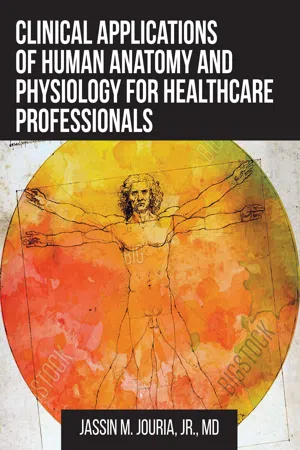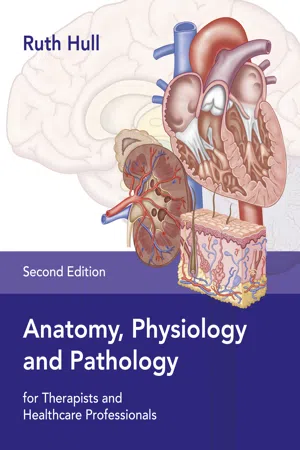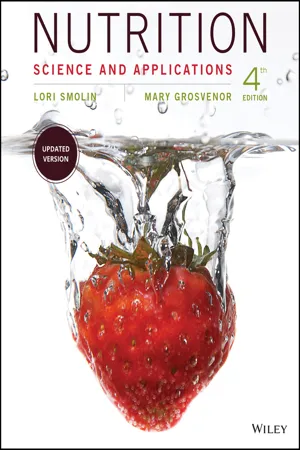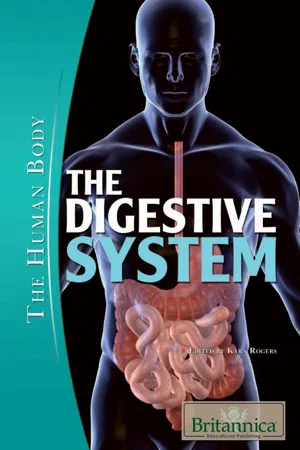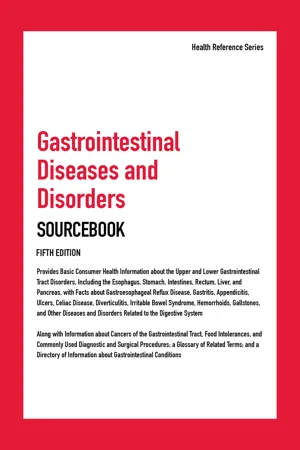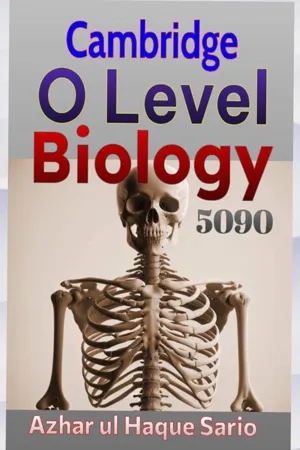Biological Sciences
Human Digestive System
The human digestive system is a complex network of organs and glands that work together to break down food into nutrients that the body can absorb and use for energy, growth, and repair. It includes the mouth, esophagus, stomach, small and large intestines, liver, and pancreas. Digestion involves mechanical and chemical processes that transform food into molecules that can be absorbed into the bloodstream.
Written by Perlego with AI-assistance
Related key terms
11 Key excerpts on "Human Digestive System"
- eBook - ePub
The Human Body
Linking Structure and Function
- Bruce M. Carlson, Bruce M. Carlson(Authors)
- 2018(Publication Date)
- Academic Press(Publisher)
Chapter 12 The Digestive System Abstract The digestive system is well adapted for ingesting food, breaking it down, both mechanically and enzymatically, and then absorbing the breakdown products and transporting them to the liver. Separate processes are involved in digesting carbohydrates, proteins, and lipids. Many aspects of the digestive process are regulated by neural (autonomic) and local hormonal influences. The structure of the gastric mucosa is well designed to both produce and protect itself from the low pH generated by the secreted hydrochloric acid. The exocrine pancreas produces many digestive enzymes in an inactive form. Activation usually occurs within the lumen of the small intestine. The liver receives the bulk of the absorbed nutrients via the portal vein and then uses them for the synthesis of many larger molecules. The intestinal microbiome includes many more cells than the number present in the human body. These microbes have evolved symbiotically along with the digestive system. Keywords Digestive system; lips; oral cavity; teeth; pharynx; tongue; esophagus; stomach; small and large intestines; anus; liver; pancreas; salivary glands; hydrochloric acid; digestion; absorption; microbiome; taste; digestive enzymes The digestive tract is one of the most remarkable organ systems in the body. It is essentially a long tube through which food and liquid enter at one end and, after a lot of processing, emerge from the other end as feces (Fig. 12.1). Through this entire journey, the ingested food is subjected to a large number of mechanical and chemical influences that help to extract the maximum amount of nutrients from the food and absorb these nutrients into the body - Jassin M. Jouria(Author)
- 2018(Publication Date)
- BrownWalker Press(Publisher)
It’s also responsible for storage as well as the secretion of solid waste. The primary digestive system processes are defined as:• Ingestion• Digestion• AbsorptionThe gastrointestinal tract incorporates the functional activities of numerous regions, tissues, and organs in the body; from saliva produced in the mouth to the pancreas, the stomach, spleen, liver, and intestines. Biliary fluids and digestive enzymes, in addition to gastrointestinal hormones, work together to promote overall digestive function and health.Without these functions, the body would not be able to absorb adequate nutrients. Lack of essential nutrients in the body contributes to many imbalances and illnesses of the body.Figure 10-1 The digestive system.In this chapter, students will learn about the anatomical positioning and functions of various components of the digestive system. An examination of the digestive activities, enteric system functions that facilitate digestive motility and regulation, plus a number of digestive processes will be discussed. A basic overview of the physiology of digestion and the processing of nutrients will also be covered, as will physiologic changes in digestive system organs or functions that can contribute to a number of ailments.Figure 10-2 Abdominal quadrants.- ■ Digestive System Anatomical Overview
Before delving into an overview of the major components and functions of the digestive system, a brief review regarding anatomical positioning is required. As defined in earlier chapters, abdominal regions are divided into nine quadrants:- eBook - ePub
- Ruth Hull(Author)
- 2021(Publication Date)
- Lotus Publishing(Publisher)
11 The Digestive System IntroductionAn average person eats approximately 500 kg of food per year, and this food gets converted into energy that the body can use to move, breathe, function, build and repair itself. Then the waste is excreted. This amazing transformation of food takes place in the gastrointestinal tract, a 7.6 metre tube running from the mouth to the anus, and in this chapter we will follow the journey of our food through this tract.Student objectives By the end of this chapter you will be able to:• Describe the functions of the digestive system• Describe the organisation of the gastrointestinal system• Identify and describe the main organs and structures of digestion• Explain the chemical breakdown of carbohydrates, proteins and lipids• Identify the common pathologies of the digestive system.Functions of the Digestive SystemThe food we eat contains carbohydrates, fats, proteins, vitamins and minerals – all essential nutrients for the life of every cell. However, none of these nutrients can be used by the body in the form in which they are eaten. They must be broken down into molecules that are small enough to cross the plasma membranes of cells. These foods also carry dangerous microbes and toxins that can harm our bodies and so they need to be prevented from passing into our cells. These are the primary functions of the digestive system: to break down the foods we eat and convert them into a usable form and to destroy or eliminate dangerous substances within them.Did you know? Approximately nine litres of fluid are secreted by the digestive system every day.The functions of the digestive system can be broken down into the following six basic processes: ingestion , secretion , mixing and propulsion , digestion , absorption , and defecation .Ingestion Ingestion is the process of taking food into the mouth. Secretion Some organs and structures of the digestive system secrete mucus, water, acid, buffers and enzymes. All of these secretions function in helping move and digest food. - eBook - ePub
The Everything Guide to Anatomy and Physiology
All You Need to Know about How the Human Body Works
- Kevin Langford(Author)
- 2015(Publication Date)
- Everything(Publisher)
Chapter 14 Digestive System The human body is an extremely complex machine. Just like any mechanical device, it requires fuel to power itself. This power is derived from raw material that becomes energy, and this energy is processed in the digestive system. The digestive system can be thought of as a long internal tube (alimentary canal). Food enters your mouth and is processed via mechanical and chemical digestion as it is propelled along the meters of your digestive tract. In the final portion of this tube, your intestines stop digesting the material and begin absorbing nutrients into your lymphatic and circulatory systems. The essential materials that your cells and tissues rely on for survival are then distributed throughout the body. Mouth The oral cavity (mouth) is defined as the space bounded by your lips (anteriorly), cheeks (laterally), and the palate (superiorly). In this space, food will be processed by mechanical means (teeth), chemically modified (saliva), and moved into the esophagus by the tongue. Raw materials begin this journey by first passing through the opening (stomodeum), defined by the lips. Teeth Made up of the hardest substance in the body and similar in many respects to bone, the teeth are the cutting and grinding implements that begin the mechanical breakdown of ingested food. All teeth consist of a portion that rises above the gum line (gingiva), which is called the crown, and the portion below the gum line (root). Covering the crown of the tooth is a brilliant white, calcium-rich material called enamel. Unlike bone, enamel has no cells and will not repair or produce new enamel. In time, enamel will slowly wear away or be degraded by bacterial enzymes (dental caries or cavities). Beneath the enamel is the core of the tooth, which is composed of dentin. This living tissue is similar to, yet harder than, bone and surrounds the pulp cavity where blood vessels and nerves reside - eBook - ePub
Nutrition
Science and Applications
- Lori A. Smolin, Mary B. Grosvenor(Authors)
- 2019(Publication Date)
- Wiley(Publisher)
hormones that help regulate food intake and the function of digestive organs. The nervous system aids in digestion by sending nerve signals that help control the passage of food through the digestive tract. Once absorbed, nutrients are transported to individual cells by the cardiovascular system. The body’s urinary, respiratory, and integumentary systems allow the elimination of metabolic waste products.3.2 The Digestive System
LEARNING OBJECTIVES
- Define digestion and absorption.
- Explain the roles of mucus, enzymes, nerves, and hormones in digestion.
The digestive system provides two major functions: digestion and absorption . Most food must be digested in order for the nutrients it contains to be absorbed into the body. When you eat a taco, for example, the tortilla, meat, cheese, lettuce, and tomato are broken apart, releasing the nutrients and other food components they contain. Water, vitamins, and minerals are absorbed without being broken into smaller units, but proteins, carbohydrates, and fats must be digested further. Proteins are broken down into amino acids, most of the carbohydrate is broken down into sugars, and most fats are digested to yield fatty acids and other digestive products. The sugars, amino acids, and fatty acids can then be absorbed into the body. The fiber in whole grains, fruits, and vegetables cannot be digested and therefore is not absorbed from the digestive tract into the body. It and other unabsorbed substances pass through the digestive tract and are eliminated in feces .Organs of the Digestive System
The digestive system consists of the gastrointestinal tract and accessory organs (Figure 3.2a ). The gastrointestinal tract is a hollow tube, about 30 feet in length, that runs from the mouth, where food enters, to the anus, where waste from that food leaves the body. It is also called the GI tract, gut, digestive tract, intestinal tract, and alimentary canal. The organs of the gastrointestinal tract include the mouth, pharynx, esophagus, stomach, small intestine, and large intestine. The inside of the tube that these organs form is called the lumen (Figure 3.2b - eBook - ePub
- Britannica Educational Publishing, Kara Rogers(Authors)
- 2010(Publication Date)
- Britannica Educational Publishing(Publisher)
CHAPTER 5 FEATURES OF THE DIGESTIVE TRACTT hrough the act of eating, or ingestion, nutrients enter the body, and it is the role of the digestive system to then render these nutrients useful to cells. Many nutrient molecules are so large and complex that they must be split into smaller molecules before they can be used by cells. This process of breaking down food into molecular particles of usable size and content is called digestion. Each segment of the digestive tract carries out a specific function in the larger process of digestion, and collectively the entire system enables the efficient extraction of nutrients and the disposal of wastes. Thus, nutrient digestion and absorption form the two major functions of the digestive system.The digestive tract is also equipped with special features to deal with nonnutrient entities from the external environment that enter the body. For example, it is designed to facilitate the movement of gases such as air swallowed with food and methane produced by gut bacteria, and to protect against infectious organisms that may accompany food into the body. In fact, the digestive system serves as an important resource for immune defense, with unique epithelial barriers and supplies of immune cells called lymphocytes, which are constantly ready for dispatch upon entry and detection of a potentially harmful agent.ROLE OF DIGESTION
Cells require a constant source of energy in order to function. In humans this energy comes primarily from the nutrients found in foods. Some nutrients serve as raw materials for the synthesis of cellular material. Others (e.g., many vitamins) act as regulators of chemical reactions; and still others, upon oxidation, yield energy. Not all nutrients, however, are in a form suitable for immediate use by the body. Some must undergo physical and chemical changes before they can serve as energy or cell substance. This function is fulfilled by digestion. - (Author)
- 2022(Publication Date)
- Omnigraphics(Publisher)
Part 1 | Introduction to the Digestive SystemChapter 1 | Your Digestive System and How It WorksWhat Is the Digestive System?1The digestive system is made up of the gastrointestinal (GI) tract—also called the “GI tract” or “digestive tract”—and the liver, pancreas, and gallbladder. The GI tract is a series of hollow organs joined in a long, twisting tube from the mouth to the anus. The hollow organs that make up the GI tract are the mouth, esophagus, stomach, small intestine, large intestine, and anus. The liver, pancreas, and gallbladder are the solid organs of the digestive system (refer to Figure 1.1 ).The small intestine has three parts. The first part is called the “duodenum.” The jejunum is in the middle, and the ileum is at the end. The large intestine includes the appendix, cecum, colon, and rectum. The appendix is a finger-shaped pouch attached to the cecum. The cecum is the first part of the large intestine. The colon is next. The rectum is the end of the large intestine.Bacteria in your GI tract, also called “gut flora” or “microbiome,” help with digestion. Parts of your nervous and circulatory systems also help. Working together, nerves, hormones, bacteria, blood, and the organs of your digestive system digest the foods and liquids you eat or drink each day.Figure 1.1. Digestive System of the Human BodyWhy Is Digestion Important?1Digestion is important because your body needs nutrients from food and drink to work properly and stay healthy. Proteins, fats, carbohydrates, vitamins, minerals, and water are nutrients. Your digestive system breaks nutrients into parts small enough for your body to absorb and use for energy, growth, and cell repair.- Proteins break into amino acids.
- Fats break into fatty acids and glycerol.
- Carbohydrates break into simple sugars.
How Does Your Digestive System Work?1Each part of your digestive system helps move food and liquid through your GI tract, break food and liquid into smaller parts, or both. Once foods are broken into small enough parts, your body can absorb and move the nutrients to where they are needed. Your large intestine absorbs water, and the waste products of digestion become stool. Nerves and hormones help control the digestive process. The digestive process of an organ and its movement are shown in Table 1.1- eBook - ePub
Fundamentals of Children and Young People's Anatomy and Physiology
A Textbook for Nursing and Healthcare Students
- Ian Peate, Elizabeth Gormley-Fleming, Ian Peate, Elizabeth Gormley-Fleming(Authors)
- 2021(Publication Date)
- Wiley-Blackwell(Publisher)
This chapter will later provide an outline of the functions of the digestive system in relation to the nutrients that the body requires to maintain normal healthy functioning. The structure and function of each part of the digestive system will be considered in detail, with each structure’s role in the digestion of nutrients or elimination of waste clearly stated. There will be questions, activities and case studies throughout the text to help you to process this information, and to gain an understanding to a level that will allow you to apply it to practice.The common nutrient groups that can only be gained from ingestion of food and drink are carbohydrates, fats and proteins. These are broken down by the processes of mechanical and chemical digestion. Mechanical digestion can be defined as the use of movement to break food matter into smaller particles and to mix food matter with digestive enzymes. Chemical digestion can be defined as the use of the chemicals (acids, enzymes) in digestive juices to break down food matter into its constituent components, which can then be absorbed into the blood or lymph.The structures associated with the digestion of food.Figure 12.1Carbohydrates
Carbohydrates contain carbon, hydrogen and oxygen atoms. Large, complex carbohydrates (starches) are metabolised into sugars, which pass from the gastrointestinal tract into the bloodstream. The breaking down of complex carbohydrates takes time, and leads to slow release of sugars, giving a sustainable source of energy. The simplest sugar is glucose (C6 H12 O6 ). This is used by cells for energy. In the presence of insulin (see Chapter 11 ), it is transported from the blood across the cell membrane. Inside the cell, aerobic respiration takes place (adding oxygen to break down the glucose and release energy – see Chapter 10 ). The waste products are then carbon dioxide (CO2 – which passes back into the blood for exhalation at the lungs – see Chapter 10 - eBook - ePub
- Azhar ul Haque Sario, Azhar ul Haque Sario(Authors)
- 2023(Publication Date)
- tredition(Publisher)
Storage of Bile: The bile produced by the liver is stored and concentrated in the gall bladder. When we eat, especially foods rich in fats, the gall bladder contracts, releasing bile into the small intestine to assist in fat digestion.In summary, these regions of the digestive system work in concert to ensure that nutrients from the food we eat are efficiently broken down and absorbed. This complex interplay of organs and enzymes is essential for maintaining the body's energy balance and overall health.The Human Digestive System is a complex and efficient system designed to convert food into energy and essential nutrients required by the body. Three important components of this system are the pancreas, the ileum and colon, and the rectum and anus, each playing a distinct role in the digestive process.Pancreas – Alkaline Secretion Containing Amylase, Protease, and LipaseThe pancreas, a vital organ in the digestive system, performs crucial functions primarily related to digestion and blood sugar regulation. It secretes an alkaline fluid that contains digestive enzymes, crucial for breaking down various components of the food we consume.Amylase: This enzyme specializes in breaking down carbohydrates into simpler sugars. When food enters the small intestine from the stomach, pancreatic amylase acts on the starches, transforming them into maltose, a simpler sugar, facilitating easier absorption.Protease: This is crucial as proteins are complex molecules, and breaking them into simpler forms allows for their absorption into the bloodstream.Lipase: This enzyme is responsible for breaking down lipids (fats) into fatty acids and glycerol. Lipase ensures that fats are converted into forms that can be easily absorbed by the intestinal lining.The alkaline nature of the pancreatic secretion is also significant. It neutralizes the acidic chyme (partially digested food) that comes from the stomach, creating an optimal pH environment for the function of digestive enzymes in the small intestine. - eBook - ePub
- Joann Colville, Sharon Oien(Authors)
- 2016(Publication Date)
- Mosby(Publisher)
sx .(See the rest of the story at the end of this chapter.)The Digestive System
Back in Chapters 7 and 8 , you learned that the functions of the cardiovascular system and of blood were to carry, among other substances, oxygen, carbon dioxide, and nutrients. The animal you are building system by system now has the respiratory system needed to exchange oxygen and carbon dioxide. It is time to learn about how this animal deals with the food it eats and what happens to turn the food into usable nutrients (Table 10-1 ). The digestive system does all of this.TABLE 10-1 Word Parts Associated with Digestive System FunctionsWord Part Meaning Example and Definition Word Parts omni- all, every omnivision seeing everything or perceiving all things omni- = all, everyvision = seeing, sight -vore eat, devour, swallow omnivore animal that eats all kinds of plants and animals omni- = all, every-vore = eat, devour, swallow herbi- plant, green crop herbivore animal that subsists on a diet consisting of only plants herbi- = plant, green crop-vore = eat, devour, swallow carni- flesh, meat carnivore animal that subsists on a diet consisting of only meat carni- = flesh, meat-vore = eat, devour, swallow peps/opept/o digestion apepsia lack of digestion a- = without, no, notpeps/o = digestion-ia = pertaining to bradypeptic pertaining to slow digestion Is this where Pepto-Bismol® gets its name? It claims to help relieve the symptoms of indigestion. What about Pepsi Cola® ? brady- = slowpept/o = digestion-ic = pertaining to - Leslie Bonci(Author)
- 2007(Publication Date)
- Trade Paper Press(Publisher)
PART ONE Understanding Your Digestive SystemPassage contains an image CHAPTER 1 How Your Gut Works
It is important to have a basic understanding of digestion in order to develop gut-friendly food choices and eating behaviors. Many people think that the process of digestion doesn’t begin until food gets into the stomach. It may surprise you to know that digestion begins as soon as the food enters your mouth, and actually even before you start to eat.Researchers have shown that the taste, texture, smell, and appearance of food may affect the body’s ability to absorb nutrients. At the beginning of a meal, even before you start to eat, the brain sends signals to the digestive tract. In the mouth, this results in the secretion of saliva. In the stomach, gastric juices are secreted. In the small intestine, digestive enzymes are released as is the flow of pancreatic juices. If you don’t like the way a food looks, smells, or tastes, the body may secrete fewer digestive juices, and the body’s ability to move food through the digestive tract may be slower than it would normally be.To help your body get the maximum benefit from the foods you eat, practice these good eating habits:• While eating, try to focus on the food, not the TV, computer, or newspaper. • Take small bites. • Chew well—don’t bite off more than you can chew! • Eat slowly. • If you can, sit when you eat, and relax. • Offer appropriately sized portions to children with digestive disorders. • If you wear dentures, make sure they fit well, so you can chew foods thoroughly. Bottom Line _________________________________If you want to digest foods well, they should look good, smell good, and taste good. In addition to food choices, good eating habits can add to the enjoyment of a meal. IN THE MOUTHWhat happens to that turkey sandwich you have for lunch? The digestion that occurs in the mouth is both mechanical and chemical. Your teeth and tongue are involved in mechanical digestion, helping you to grind and mix the food to make it easier to swallow. Saliva secreted from salivary glands provides the chemical digestion, which helps to break down foods in the mouth. Three types of saliva are produced in response to different types of foods:
Index pages curate the most relevant extracts from our library of academic textbooks. They’ve been created using an in-house natural language model (NLM), each adding context and meaning to key research topics.
